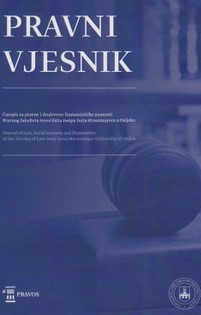IMOVINSKO PRAVNI POLOŽAJ ŽENE U BRAKU NA PRIJELAZU IZ 19. U 20. STOLJEĆE – PREMA SADRŽAJU PRIVATNOPRAVNIH ISPRAVA
PROPERTY RIGHTS OF A MARRIED WOMAN AT THE TURN OF THE 19TH AND 20TH CENTURIES – ACCORDING TO THE CONTENT OF PRIVATE DOCUMENTS
Author(s): Jelena KasapSubject(s): History of Law, Civil Law, Gender history, 19th Century, Pre-WW I & WW I (1900 -1919), Socio-Economic Research, Comparative Law
Published by: Pravni fakultet Sveučilišta Josipa Jurja Strossmayera u Osijeku
Keywords: marriage contracts; property rights; marital property; testaments; Osijek; Baranja;
Summary/Abstract: Drawing up marriage contracts in order to achieve the autonomy of the parties with regard to property relations in marriage in the period after the entry into force of the Austrian General Civil Code has become a common practice. A very detailed normative framework for the regulation of individual institutes of marital law left enough space to regulate property relations between spouses in accordance with their requirements and with the purpose of preserving the economic interests of the family and each partner. In the period in which a man took over the function of managing marital property, and the position of a married woman was marked by patterns of desirable behaviour, a number of property dispositions were recorded with the purpose of strengthening a woman’s position in society during marriage, but also securing her status in the case of termination of marriage. Guided by the idea of modernizing the social position of women in the period after the entry into force of the Austrian Civil Code, the basic purpose of this research is to determine the position of women in terms of property rights acquired on the basis of private legal documents. This refers to the institutes included in the content of marriage contracts preserved in the State Archives in Osijek and the effects of wills, which often contained marriage provisions, but also those wills whose creators often sought to provide property protection for poor women by establishing foundations. Available documents come from different legal areas of urban (Osijek) and rural (Baranja) areas, which makes them a valuable material for a comparative analysis of various issues, from applicable law to the effects of its application. Therefore, this research uses a legal-historical method and a comparison of the obtained results to try to determine the effects of marriage law and the impact of contractual dispositions on the economic and legal strengthening of the position of women in the society in the second half of the 19th century.
- Issue Year: 38/2022
- Issue No: 1
- Page Range: 9-29
- Page Count: 21
- Language: Croatian

